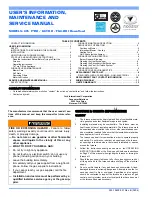
29
• Use listed gas appliance connectors in accordance
with their instructions. Connectors must be fully in the
same room as the furnace.
• Protect connectors and semirigid tubing against
physical and thermal damage when installed. Ensure
aluminum-alloy tubing and connectors are coated to
protect against external corrosion when in contact
with masonry, plaster, or insulation, or subjected to
repeated wetting by liquids such as water (except rain
water), detergents, or sewage.
The gas piping may enter the left or right side of the
furnace cabinet. The installer must supply following fittings
starting from the gas valve.
•
1/2” dia x 2” long nipple
• 90 degree elbow
• Additional length of rigid piping enough to reach the
outside of the cabinet
• Grounded joint union
•
Drip leg
•
Manual gas shut off valve
A semi-rigid connector to the gas piping can be used
outside the cabinet per local codes. ½” NPT pipe and
fittings are required. Model requires one 90 degree elbow,
one 2” nipple and additional nipple to reach outside the
cabinet.
A semi-rigid connector to the gas piping can be used
outside the cabinet per local codes. From the elbow, the
length of pipe and the fittings required will vary by the side
chosen, location of union and cabinet width. The union may
be placed inside or outside of the cabinet.
Alternate
Gas Line
Location
Plug in
Alternate
Gas Line
Hole
* Ground
Joint
Pipe
Union
Gas Valve
*Ground
Joint
Pipe
Union
Manual Shut Off Valve
(upstream from
ground joint
pipe union)
Grommet
in Standard
Gas Line
Hole
Drip Leg
Burner
Manifold
* NOTE: Union may be inside furnace cabinet where allowed by local codes.
Upflow
Figure 44
Manual Shut Off Valve
(upstream from
ground joint pipe union)
Drip Leg
Plug in Alternate Gas Line Hole
Grommet in
Standard Gas Line Hole
Alternate
Union
Location
Burner
Drain Trap
Gas Valve
Plug in Main Gas Line Hole
Manifold
Upflow - Horizontal Left
Figure 45
Gas Piping Checks
WARNING
To avoid the possibility of explosion or fire, never use a
match or open flame to test for leaks.
Before placing unit in operation, leak test the unit and gas
connections.
Check for leaks using an approved chloride-free soap and
water solution, an electronic combustible gas detector, or
other approved testing methods.
CAUTION
To prevent possible property damage or personal injury
due to fire, the following instructions must be performed
regarding gas connections, pressure testing, location of
shutoff valve and installation of gas piping.
NOTE: Never exceed specified pressures for
testing. Higher pressure may damage the gas valve
and cause subsequent overfiring, resulting in heat
exchanger failure.
Disconnect this unit and shutoff valve from the gas supply
piping system before pressure testing the supply piping
system with pressures in excess of ½ psig (3.48 kPa).
















































